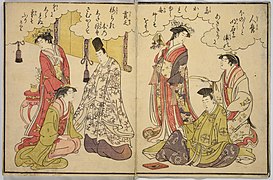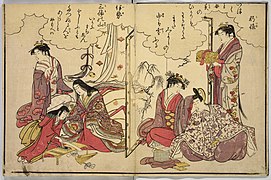Hosoda Eishi
Hosoda Eishi ( Japanese 細 田 栄 之 , real name: Hosoda Tokitomi (細 田 時 富), stage name : Chōbunsai (鳥 文 斎), also won as Hosoi (細 井); born 1756 ; died July 2, 1829 ) was a Japanese Ukiyoe - Artist during the middle Edo period .
life and work
Hosoda Eishi was a Hatamoto , i.e. a higher samurai who lived in Edo . He was the grandson of Hosoda Tokitoshi (細 田 時 敏), who had made it up to the commissioner for finances of the shogunate (勘定 奉行, Kanjō bugyō). Eishi, who had an annual income of 500 koku , began his artistic training under Kanō Eisen-in Michinobu (狩 野 英 川 院 典 信), who was the official painter of the Shogunate, and then put it under Torii Bunryūsai (鳥 居 文 龍 斎; late 18th century). He showed considerable talent early on, and it is said that the Shogun Tokugawa Ieharu , for whom he worked, supported his career and bestowed him with the name Eishi. In 1783 Eishi asked to be relieved of his duties as Hatamoto due to illness. The following year he made illustrations for the book of the type Kibiyōshi (黄 表 紙) with the title "Sono yurai Kōtokujimon" (其 由来 光 徳 寺門). That was his first appearance as an ukiyoe artist.
In 1789, the shogunate began a series of measures to regulate the morale of society, measures that are known today under the term Kansei reforms (寛 政 の 改革, Kansei no kaikaku), named after the Kansei reign (1789–1801). Eishi feared that as a subordinate of the shogunate, he might get into trouble because of his frivolous activities. So he adopted his younger sister and tried to find a husband who would then run the Hosoda house. He succeeded, and so he was relatively free to pursue his artistic activities.
He became one of the leading ukiyoe artists of the time in the Kansei era. He created both woodcuts and original paintings on which he depicted a large-figured, elegant world of women. Among these works is a series of triptychs in Ōban format (each sheet about 37 × 25 cm) with the titles "Seirō bisen awase" (青楼 美 撰 合 わ せ) and "Seirō geishasen" (青楼 芸 者 撰). Icei's pupil Eishō (栄 昌; active 1780 to 1800), Eisui (栄 水), Eiri (steller 里), Eishin (栄 深) and others were also excellent performers of beautiful women. Kitagawa Utamaro , the most important painter of beautiful women of the time, was for a time heavily influenced by Eishi.
Eishi, who had learned orthodox painting under a painter from the Kanō school , showed his special skills above all in original paintings, to which he devoted all his energies in the last years of his life. In 1800 he showed one of his works to the retired Empress Go-Sakuramachi show, who was very impressed by it and bought it for her collection. In order to give an appropriate reminder of this acquisition, Eishi is said to have cut a seal with the characters “tenran” (天 覧), meaning “seen by the empress”. - Unlike most ukiyoe artists, he is said to have performed particularly dignified.
photos
Remarks
- ↑ Seirō (青楼), "Green Pavilions", was the usual name for prostitute houses.
literature
Museum of Modern Art, Kyoto, 1986. ISBN 4-87642-117-X .
- Tazawa, Yutaka: Hosoda Eishi . In: Biographical Dictionary of Japanese Art. Kodansha International, 1981. ISBN 0-87011-488-3 .
- Laurance P. Roberts: Eishi . In: A Dictionary of Japanese Artists. Weatherhill, 1976. ISBN 0-8348-0113-2 .
Web links
| personal data | |
|---|---|
| SURNAME | Hosoda, Eishi |
| ALTERNATIVE NAMES | 細 田 栄 之 (Japanese); Hosoda Tokitomi (real name); 細 田 時 富 (real name, Japanese) |
| BRIEF DESCRIPTION | Japanese painter |
| DATE OF BIRTH | 1756 |
| DATE OF DEATH | July 2, 1829 |






